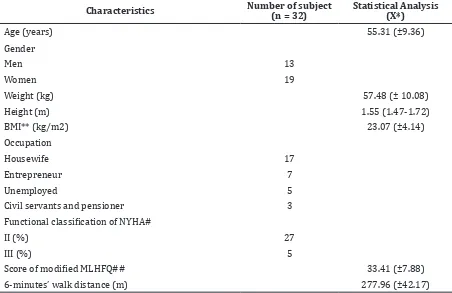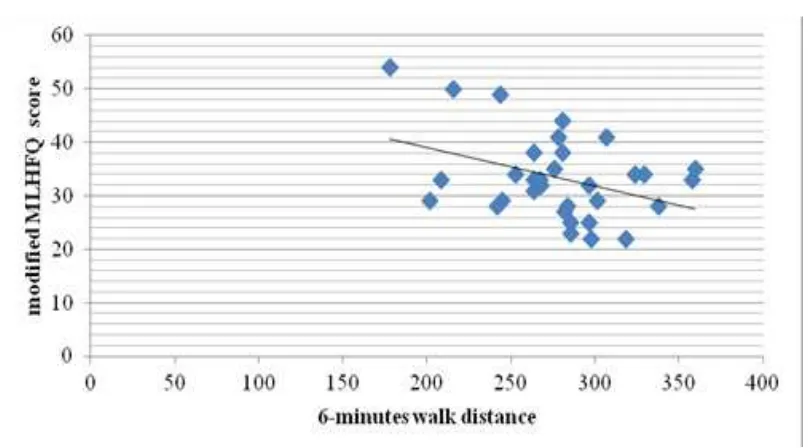Correlation between Six-Minutes’ Walk Test and Quality of Life
in Heart Failure Patients
Syifa Rahmani,1 Erwinanto,2 Rudolf Andean3
1Faculty of Medicine Universitas Padjadjaran, 2Department of Cardiology and Vascular Medicine Faculty of Medicine Universitas Padjadjaran/Dr. Hasan Sadikin General Hospital Bandung,
3Department of Physiology Faculty of Medicine Universitas Padjadjaran
Abstract
Background: The problem of heart failure patient relates with reduced functional capacity and eventually leads to declined quality of life (QoL). Improved QoL may not relate to better functional capacity since QoL
is influenced by patient’s expectation to the on-going treatment. This study was conducted to investigate the correlation between six-minutes’ walk test (6MWT) as a measure for functional capacity and QoL of heart
failure patient in Dr. Hasan Sadikin General Hospital.
Methods: This cross sectional study involved 32 patients who were on planned visit at the outpatient clinic of Dr. Hasan Sadikin General Hospital Bandung from September to October 2013. Subjects were chosen
using consecutive sampling. The correlation of 6MWT and QoL assessed using modified Minnesota Living and Heart Failure Questionnaire (MLHFQ) was analyzed through Pearson’s correlation test.
Results: There was a significant correlation between distance covered in 6MWT and QoL (r=-0.354, p<0.05).
The mean of six-minute walk distance was 277.96 (±42.17) and mean of QoL score was 33.41 (±7.88). In accordance with the findings in previous studies, this study revealed correlation between the distance obtained in 6MWT and the QoL score in heart failure patient.
Conclusions: There is correlation between 6MWT and quality of life in outpatients with heart failure at Dr. Hasan Sadikin General Hospital. [AMJ.2015;2(4):469–73]
Keywords: Heart failure, quality of life, six-minutes’ walk test
Correspondence: Syifa Rahmani, Faculty of Medicine, Universitas Padjadjaran, Jalan Raya Bandung-Sumedang Km.21,
Jatinangor, Sumedang, Indonesia, Phone: +6281321635192, Email: [email protected]
Introduction
Heart failure incidence is reported to be increasing not only due to aging, but also due to successful current therapies of cardiac disorder patients with prolong survival.1,2 Assessment of quality of life (QOL) in patients with heart failure is important to evaluate health influences in holistic aspects; including physical, emotional and social function. This can be made as consideration for doctor to give individual therapy.3 Clinical symptoms in the patients, which limit their activities in daily living, impair their QOL.4 QOL impairment in the patient may be due to psychological problems, adverse effect of treatment, social limitation, and socio-economic problems.3,5
Considering those factors, QOL may be irrelevant with functional capacity. The clinical symptoms are also associated with their
functional capacity which can be assessed sub maximally through six-minutes’ walk test (6MWT).5,6
Several studies have been conducted to investigate the correlation between 6MWT and QOL.7,8 Previous studies demonstrate significant correlation between the two variables (6MWT and QOL).7,8 In addition to
populations.
Methods
An analytical cross sectional study was conducted from September to October 2013 using primary data of the patients who were on planned visit at outpatient the clinic of Dr. Hasan Sadikin General Hospital. A total of 32 subjects were determined by calculating minimum sample size. Consecutive sampling technique was used as the sampling method. Inclusion criteria included patients with stable chronic HF with New York Heart Association (NYHA) functional class II and III, aged at least 18 years old, and were able to understand Indonesian language. Subjects were excluded if the patients were found to have unstable angina or myocardial infarction during last one month, pulse during rest higher than 120 bpm, systolic pressure higher than 180 mmHg, and diastolic pressure higher than 100 mmHg. Other than that, the excluded patients were also those with physical limitation due to other factors besides heart failure, e.g; musculoskeletal problems and pulmonary
disease, mental illness that may hinder patients from answering questionnaire, stroke in last two months, anemia, infection, and incomplete data of questionnaire. Prior to that, the subjects involved in this study were given information and signed consent approved by Ethical Committee of the institution.
The QOL was evaluated using specific instrument, namely modified Minnesota Living with Heart Failure Questionnaire (MLHFQ), which had been translated into Indonesian language. The MLHFQ has comprehensive questions that measures the most relevant domain of QOL related to heart failure, including physical and emotional domains.5,10 However, question about sexual activity was investigated as not valid by Kaawoan.11 The MLHFQ used in this study was considered as modified MLHFQ consisting of 20 questions with 1−4 scale. The total score would be in the range of 20−80, where 80 indicated the poorest QOL.
Functional capacity was evaluated by performing 6MWT which has been proved as valid, simple, safe and useful tool.12 The 6MWT was conducted in 20 m indoor corridor by single
Table 1 Characteristics of Subjects
Characteristics Number of subject
Weight (kg) 57.48 (± 10.08)
Height (m) 1.55 (1.47-1.72)
Civil servants and pensioner 3
Functional classification of NYHA#
II (%) 27
III (%) 5
Score of modified MLHFQ## 33.41 (±7.88)
6-minutes’ walk distance (m) 277.96 (±42.17)
examiner under supervision. The procedure of the test was performed according to the protocol of American Thoracic Society (ATS). Patients were allowed to self-pace and rest as needed as they traversed back and forth along a marked walkaway. Standardized phrases were used while speaking to the subjects during the tests. At the end, the total distance achieved in six minutes was measured.
Statistical study was analyzed using Statistical Product and Service Solution version 13.0. Saphiro Wilk test was used for determining distribution of data in each variable. If the data were normally distributed, Pearson correlation test was performed to analyze the correlation between the distance of 6MWT and the QOL score. The score of P<0.05 meant that it was statistically significant.
Results
The characteristics of subjects, six-minutes’ walk distance and modified MLHFQ score, are summarized in Table 1. All subjects successfully accomplished 6MWT. Some subjects stopped for a while in the middle of the test due to mild dyspnea, then continued their walking. There were no severe complaints occurred during or after the tests.
Saphiro Wilk normality test showed that the data of modified MLHFQ score and 6MWT distance were normally distributed. Pearson
correlation test between distance obtained in 6MWT and score of modified MLHFQ revealed weak and significant negative correlation (r=-0,354, p=0,047), which meant that 6-minutes’ walk distance was inversely correlated to modified MLHFQ score (Figure 1).
Discussion
Measurement of QOL is considered important to evaluate the influence of disease in patients’ life and how the patients confront it.3 The mean of modified MLHFQ score in this study (33.34 ± 7.88) was lower than the study in Brazil, which suggested better QOL.7,8 Ethnicity is known to have association with different QOL in distinct populations.9 Moreover, cross-cultural study between individualism and collectivism showed that country of residence has an overwhelming impact on QOL (F4,666=59.31, p<0.001).13 Other factors influencing QOL in heart failure patients are NYHA functional classification, personality motivation, gender, and age.4,14
The 6MWT is beneficial to observe functional status and predict mortality of the patients with heart failure.6,15 In this study, the mean of six-minutes’ walk distance (6MWD) was 277.96 meters (SD ±42.17) which was lower than that of the studies in Brazil.7,8 The difference may be due to several factors such as body height, body weight,
gender, motivation, and previous experience in performing the test.16 Morbidity, NYHA functional classification, medication, and age also influence the distance in 6MWT.16
This study elucidates that there was significant negative correlation between the distance covered in 6MWT and the QOL in HF patient (r=-0.354, p<0,05). The longer the distance in 6MWT implicates lower modified MLHFQ score, which means better QOL. The correlation may occur since MLHFQ consists of questions measuring the physical ability in HF patient, such as walking and climbing stairs.10 Declined physical ability lowers the QOL of heart failure patients.5 In the other hand, 6MWT reflects individual’s ability to perform daily activities.6
Similar to the previous study, the result of this study showed the correlation between six-minutes walk distance and QOL in heart failure patients.7,8 Santos et al.7 showed significant and strong correlation (r=-0.62) between 6MWT and QOL measured by MLHFQ in Brazilian samples. However, the study involved man only.7 Other study conducted by Nogueira et al.8 in Brazil successfully showed the correlation between the two variables (r=-0.5). However, the 6MWT was performed twice in every subject which was different in once in every subjects in this study.8
Different length of corridor for the 6MWT between ATS recommendation (30 meters) and this study (20 meters) might be a limitation for this study.12 Shorter corridor will require patients to take more time to reverse their directions.12 However, there are no significant effects for the length ranging from 15 to 49.2 meters.12 Selection of 6MWT location according to ATS is necessary to improve validity.
In conclusion, the 6MWT correlates with quality of life measured by modified MLHFQ. Better exercise tolerance is associated with better QOL of the outpatients with heart failure at Dr. Hasan Sadikin General Hospital.
References
1. Robert O. Bonow M, Douglas L. Mann M, Douglas P. Zipes M, Peter Libby M. Braunwald’s heart disease a textbook of cardiovascular medicine. 9th ed. Philadelphia: Elsevier; 2012.
2. Mosterd A, Hoes AW. Clinical epidemiology of heart failure. Heart. 2007;93:1137−46. 3. Coelho R, Ramos S, Prata J, Bettencourt
P, Ferreira A, Cerqueira-Gomes M. Heart failure and health related quality of life. Clin
Pract Epidemiol Ment Health. 2005;1:19. 4. Lewis EF, Lamas GA, O’Meara E, Granger
CB, Dunlap ME, McKelvie RS, et al. Characterization of health-related quality of life in heart failure patients with preserved versus low ejection fraction in CHARM. Eur J Heart Fail. 2007;9(1):83−91. 5. Dunderdale K, Thompson DR, Miles
JNV, Beer SF, Furze G. Quality-of-life measurement in chronic heart failure: do we take account of the patient perspective? Eur J Heart Fail. 2005;7(4):572−82.
6. Enright PL. The six-minute walk test. Respiratory Care. 2003;48(8):783−5. 7. Santos JJA, Brofman PRS. Six-minute walk
test and quality-of-life in heart failure A correlative study with a Brazilian sample. Insuf Cardiaca. 2008;3:72−5.
8. Nogueira ID, Servantes DM, Nogueira PA, Pelcerman A, Salvetti XM, Salles F, et al. Correlation between quality of life and functional capacity in cardiac failure. Arq Bras Cardiol. 2010;95(2):238−43.
9. Riegel B, Moser DK, Rayens MK, Carlson B, Pressler SJ, Shively M, et al. Ethnic differences in quality of life in persons with heart failure. J Card Fail. 2008;14(1):41−7. 10. Rector TS, Carson PE, Anand iS, McMurray
JJ, R.ZIle M, McKelvie RS, et al. Assessment of long-term effects of Irbesartan on heart failure with preserved ejection fraction as measured by minnesota living with heart failure questionnaire in the Irbesartan in heart failure with preserved systolic function (I-Preserve) trial. Circ Heart Fail. 2012;5:217−25.
11. Kaawoan AYA. Hubungan Self Care dan depresi dengan kualitas hidup pasien Heart Failure di RSUP Prof Dr R.D. Kandou Manado [dissertation]. Depok: Universitas Indonesia; 2012.
12. American Thoracic Society. ATS statement: guidelines for the six-minute walk test. Am J Respir Crit Care Med. 2002;166(1):111−7. 13. Fu S-YK. The relationship between culture,
attitude, social networks and quality of life in midlife Australian and Taiwanese men and women [dissertation]. Brisbane: Queensland University of Technology; 2006.
14. Mathisen L, Andersen M, Veenstra M, Wahl A, Hanestad B, Fosse E. Quality of life can both influence and be an outcome of general health perceptions after heart surgery. Health Qual Life Outcomes. 2007;5:27.
value of 6-minute walk test in stable outpatients with heart failure. Tex Heart Inst J. 2007;34(2):166.
16. Enright PL, McBurnie MA, Bittner V,

